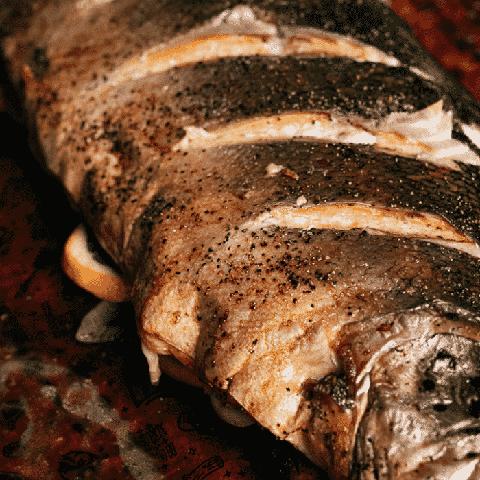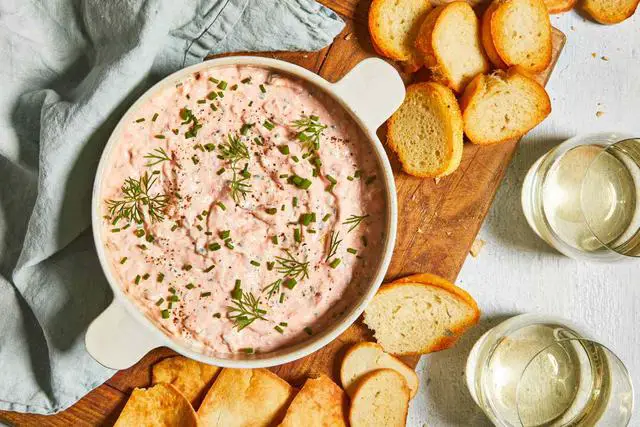
“Indulge in the ultimate seafood feast with our mouthwatering Grilled Whole Salmon. Delightfully seasoned and grilled to perfection, this succulent dish promises a tantalizing burst of flavors that will leave you craving for more. Dive into an unforgettable culinary experience that showcases the essence of fresh, tender salmon, expertly prepared to satisfy your palate.”
How to Grill a Whole Salmon

Grilling a whole salmon may seem intimidating, but it’s actually quite easy and affordable. Here are the steps to grill a whole salmon to perfection:
1. Brine the salmon: While this step is optional, brining the salmon overnight in a mixture of brown sugar, salt, and water can add moisture and flavor to the fish. Make sure the salmon is fully submerged in the brine and refrigerate it for at least one hour or overnight.
2. Preheat the grill: Heat your grill to 400°F. If using a pellet grill like Traeger, choose your favorite pellets for added smokiness.
3. Prepare the salmon: Pat the salmon dry inside and out. Coat it with olive oil and season with salt and pepper. Stuff the cavity with slices of onion, lemon, lime, garlic, as well as herbs like thyme, tarragon, and parsley.
4. Grill the salmon: Place the salmon on the hot grill grates and close the lid. Grill for 20 to 30 minutes or until the internal temperature reaches 130°F for medium-rare doneness. Use a meat thermometer for accuracy.
5. Make lemon-chive butter sauce: While the salmon is cooking, melt butter in a saucepan over medium heat. Add salt, pepper, garlic, lemon juice, and chives. Cook for 5 minutes to infuse flavors.
6. Serve and enjoy: Once cooked, remove the salmon from the grill and let it rest for a few minutes before serving. Peel off the skin if desired and separate fillets by lifting them away from the spine using a spatula. Season with salt and pepper and serve alongside lemon-chive butter sauce.
Why This Recipe is So Great
This recipe is great because it provides a foolproof method for grilling a whole salmon to perfection every time. Whether you’re using a gas grill, charcoal grill, or pellet grill, this recipe will work for you.
The brining step in this recipe is optional but highly recommended. It adds moisture to the salmon and helps prevent it from drying out while grilling. Plus, it imparts flavor and helps create a beautiful presentation.
One of the best things about this recipe is that it yields leftovers that can be used in various other dishes. From salmon patties to salads, sandwiches, wraps, and even pasta, there are endless possibilities for repurposing the leftover salmon into delicious meals.
Ingredients

– 1 whole salmon (4-6 pounds)
– 1 cup brown sugar
– 1 cup salt
– Water
– Olive oil
– Salt and pepper
– Slices of onion, lemon, lime, and garlic
– Sprigs of thyme, tarragon, and parsley
– For the butter sauce:
– 1/2 cup butter
– Salt and pepper to taste
– Minced garlic
– Lemon juice from one lemon
– Chopped chives
For the optional brine
Brining the salmon is an optional step, but it improves the flavor and texture considerably. The brine helps season the meat more thoroughly, and it helps the meat stay moist and juicy. It also helps prevent the salmon from leaching out white albumin while cooking and making a prettier presentation. The white albumin is not a problem to eat, but some people get a bit squeamish when they see it on the surface of cooked salmon.
To brine the salmon, combine brown sugar, salt, and water in a medium saucepan. Bring the mixture to a simmer over medium heat, stirring constantly until the salt and sugar are completely dissolved. Remove from heat and add ice to cool it down. Pour the brining solution into a container large enough to hold the whole salmon. If the salmon isn’t completely submerged, make more of the brine and add it to the container. Cover and place in the fridge overnight or for at least one hour.
To prevent your salmon from sticking to the grill, there are several things you can do. First, grill your whole salmon with its skin on as this helps keep it from sticking. You can also coat the skin with olive oil or vegetable oil before grilling. Another tip is to use a rag or brush to coat your grill grates with vegetable oil before placing your salmon on them.
For the salmon
If you want an even more juicy and moist salmon, brine it overnight in the fridge. Combine the brown sugar, salt, and water in a medium saucepan. Bring the mixture to a simmer over medium heat and stir constantly until the salt and sugar are completely dissolved. Remove the solution from the heat and add some ice to cool it down. Pour the solution into a container large enough to contain the whole salmon. You can use the plastic produce drawer in your fridge or you can use this large food container. If the salmon isn’t completely submerged in the brining solution, make more of the brine and add it to the container. Cover the container and place it in the fridge overnight, or for at least one hour.
Preheat the grill to 400°F while you prepare the salmon. Pat the salmon dry all over, inside and out. Coat the exterior and inside cavity of the salmon with olive oil and season it with salt and pepper. Stuff the cavity of the salmon with slices of onion, lemon, lime, and garlic as well as sprigs of thyme, tarragon, and parsley. You can really stuff it full, almost to the point where it is overflowing.
Transfer the salmon to the hot grill grates and close the lid. Grill the whole salmon for 20 to 30 minutes or until the internal temperature of Salmon reaches 130°F (54°C). While cooking make sure you don’t overcook your Salmon.
For the lemon chive butter sauce
Melt the butter in a medium-sized saucepan over medium heat.
Add salt, pepper, garlic, lemon, and chives to the melted butter.
Cook the mixture for 5 minutes over medium heat to infuse the flavors into the butter.
How to Grill a Whole Salmon

Grilling a whole salmon may seem intimidating, but it is actually quite easy and affordable. Follow these steps to grill a whole salmon to perfection:
- Brine the salmon: While not necessary, brining the salmon overnight in a mixture of brown sugar, salt, and water can add moisture and flavor. Submerge the salmon in the brine solution and refrigerate for at least one hour or overnight.
- Preheat the grill: Preheat your grill to 400°F. If using a pellet grill like Traeger, choose your favorite wood pellets for added smokiness.
- Prepare the salmon: Pat the salmon dry with paper towels. Coat the exterior and cavity of the salmon with olive oil and season with salt and pepper. Stuff the cavity with slices of onion, lemon, lime, garlic, and herbs like thyme, tarragon, and parsley.
- Grill the salmon: Place the stuffed salmon on the hot grill grates and close the lid. Grill for 20-30 minutes or until the internal temperature reaches 130°F. Use a meat thermometer to ensure doneness.
- Make butter sauce: While the salmon is cooking, melt butter in a saucepan over medium heat. Add salt, pepper, garlic, lemon juice, and chives. Cook for 5 minutes to infuse flavors.
- Serve and enjoy: Once cooked, transfer the grilled salmon to a cutting board. Remove skin if desired by peeling it away from flesh. Gently lift upward with a spatula to separate top fillet from bottom fillet. Season with salt and pepper before serving alongside lemon-chive butter sauce.
Step 1: brine the salmon (optional)
To add moisture and flavor to the salmon, you can choose to brine it overnight in the fridge. In a medium saucepan, combine brown sugar, salt, and water, and heat until the sugar and salt are dissolved. Remove from heat and add ice to cool it down. Pour the brining solution into a container large enough to hold the whole salmon, making sure it is completely submerged. Cover the container and refrigerate for at least one hour or overnight. This step is optional but highly recommended for juicy and flavorful results.
Step 2: prepare the salmon
To prepare the salmon for grilling, start by patting it dry all over, both on the exterior and inside cavity. This will help remove any excess moisture and ensure a better sear on the grill. Once dry, coat the salmon with olive oil and season it generously with salt and pepper.
Next, stuff the cavity of the salmon with slices of onion, lemon, lime, and garlic. Add sprigs of thyme, tarragon, and parsley for added flavor. You can pack the cavity full, almost to the point where it is overflowing.
Once stuffed, transfer the salmon to a preheated grill at 400°F. Close the lid and let it cook for 20 to 30 minutes or until the internal temperature reaches 130°F. If you prefer a more rare salmon, you can take it off at 122°F. Use a meat thermometer to ensure accurate temperature readings.
Step 3: grill the whole salmon
Preheat the grill to 400°F and choose your preferred wood pellets for added smokiness. Pat the salmon dry all over, inside and out. Coat the exterior and inside cavity of the salmon with olive oil and season with salt and pepper.
Stuff the cavity of the salmon with slices of onion, lemon, lime, garlic, and sprigs of thyme, tarragon, and parsley. Fill it as much as you can without overflowing.
Transfer the salmon to the hot grill grates and close the lid. Grill for 20 to 30 minutes or until the internal temperature reaches 130°F. Use a meat thermometer like ThermoWorks Signals WiFi thermometer for accurate monitoring.
Step 4: make the lemon chive butter sauce
To make the lemon chive butter sauce, melt the butter in a medium-sized saucepan over medium heat. Once melted, add salt, pepper, garlic, lemon, and chives. Cook for 5 minutes to allow the flavors to infuse into the butter.
Step 5: serve the salmon
Once the salmon is cooked to your desired doneness, carefully remove it from the grill using a large spatula or fish flipper. Place it on a large counter or cutting board.
If you prefer, you can remove the skin from the salmon by peeling it away from the flesh. It should come off easily in large sections.
To separate the fillets, start at the head and slide a fish spatula or sturdy metal spatula underneath the spine. Gently lift upward to separate the top fillet from the bottom fillet, keeping most of the bones intact with the spine.
Flip over the top fillet and rest it alongside the bottom fillet. Remove and discard the spine. Use caution to support the flesh of the fish so it doesn’t break apart during this process.
Season both fillets with salt and pepper, and serve them alongside the lemon-chive butter sauce for added flavor.
Ways to Use Leftover Salmon
1. Salmon Patties: Mix the leftover salmon with breadcrumbs, egg, and seasonings to create delicious salmon patties. Pan-fry or bake them for a quick and easy meal.
2. Salmon Salad: Flake the leftover salmon into a bowl and mix it with mayonnaise, diced celery, red onion, and dill for a refreshing and flavorful salad. Serve it on top of greens or in a sandwich.
3. Salmon Wraps: Spread cream cheese or avocado onto tortillas, then add slices of leftover salmon along with your favorite veggies and herbs. Roll them up for a tasty and portable lunch option.
4. Salmon Pasta: Toss the flaked salmon with cooked pasta, olive oil, garlic, lemon juice, and fresh herbs for a light and satisfying pasta dish.
5. Salmon Sandwiches: Layer slices of leftover salmon onto bread or rolls along with lettuce, tomato, cucumber, and your favorite condiments for a delicious sandwich option.
Frequently Asked Questions

1. Do I have to brine the salmon before grilling?
Brining the salmon is an optional step, but it improves the flavor and texture considerably. The brine helps season the meat more thoroughly, and it helps the meat stay moist and juicy. It also helps prevent the salmon from leaching out white albumin while cooking and making a prettier presentation.
2. What temperature should I cook the salmon to?
The FDA recommends cooking finfish like salmon to 145°F. However, salmon gets pretty dry when it is cooked to that temperature. It is recommended to cook salmon to a temperature between 122°F and 130°F for a tender, moist, and flaky texture. Use your judgment regarding the temperature.
3. How do I prevent the salmon from sticking to the grill?
Grilling a whole salmon with the skin on will help keep the fish from sticking to the grill. You can also coat the skin in olive or vegetable oil to further prevent sticking. Additionally, you can use a rag coated with vegetable oil to grease the grill grates before cooking.
4. What are some ways to use leftover grilled salmon?
If you have leftovers, there are many creative and tasty ways to incorporate grilled salmon into other dishes. Some ideas include using it in fish tacos, salads, sandwiches, wraps, pasta dishes, or even making salmon patties.
5. Can I substitute herbs in the recipe?
Absolutely! If you don’t have certain herbs on hand or prefer different flavors, feel free to substitute them with your favorite herbs that pair well with herb butter and salmon, such as dill, savory, thyme, rosemary, sage, or basil.
Do you have to brine the salmon?
Brining the salmon is an optional step, but it improves the flavor and texture considerably. The brine helps season the meat more thoroughly, and it helps the meat stay moist and juicy. It also helps prevent the salmon from leaching out white albumin while cooking and making a prettier presentation. The white albumin is not a problem to eat, but some people get a bit squeamish when they see it on the surface of cooked salmon.
Should you rinse the salmon after the brine?
No, there is no need to rinse the salmon after brining. Simply pat it dry before seasoning and grilling. Rinsing the salmon would remove some of the flavor that has been infused during the brining process. As long as you don’t over-brine the salmon, it will not be too salty.
How do you keep salmon from sticking to the grill?
Grilling salmon can be a delicious and flavorful way to cook this fish, but one common problem is the fish sticking to the grill. To prevent this, there are a few tips you can follow:
1. Make sure your grill grates are clean and well-oiled before cooking. Using a brush or rag, coat the grates with vegetable oil or olive oil to create a non-stick surface.
2. Keep the skin on when grilling salmon. The skin helps protect the flesh from direct contact with the grill and reduces the chances of sticking. You can also lightly coat the skin with oil for added protection.
3. Preheat your grill thoroughly before adding the salmon. This will help create a hot surface that will sear the fish and prevent sticking.
4. Avoid flipping the salmon too soon. Let it cook for a few minutes on one side until it easily releases from the grill before flipping it over.
By following these tips, you can enjoy perfectly grilled salmon without worrying about it sticking to the grill.
In conclusion, grilled whole salmon is a delectable and nutritious choice for seafood lovers. Its tender and flaky texture, combined with the smoky flavors from grilling, create an irresistible dish. With its abundance of Omega-3 fatty acids and high protein content, this meal not only satisfies the taste buds but also promotes overall well-being. Whether enjoyed at a backyard barbecue or a fancy dinner party, grilled whole salmon is sure to impress any palate.
Learn More About Grilling
If you want to learn more about grilling, check out these other helpful resources!











